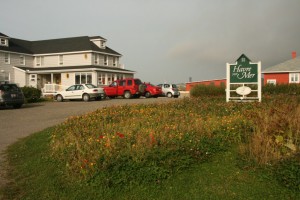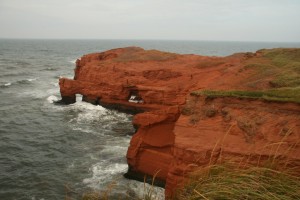Îles de la Madeleine
A friend told me about his visit to the Îles de la Madeleine while camping in Prince Edward Island. I had never heard of the place and it seemed as if he was talking about a nearby island, but the more he talked the more interested I became.
He told me of a chain of islands out in the middle of the Gulf of St. Lawrence linked by an 88 km road. He told me of its beauty and great beaches. Now he had my attention, so I did some research, and then planned a trip for the summer. It definitely sounded as if it was something that should be mentioned in one of my Stoness Scenic Travel Guides
What I discovered was a group of islands that looked as if they belonged somewhere in the South Pacific Ocean. The Îles de la Madeleine are composed of several islands with six connected by sandy causeways. Green vegetation sweeps upward from the sea to colourful high sandstone cliffs. Sea facing cliffs are carved into a myriad of shapes with caves and sea stacks. Here and there are beautiful sandy beaches, some filling a small cove, and others spreading for long distances along a sloping shore. Gaily painted houses and shops dot the bays where there is good protection from the occasionally raging sea, making ideal locations for small fishing ports. Roads that lead down to the beaches usually end in deep sandy areas that are sure to see your vehicle firmly stuck, unless you have the right vehicle and tires. Approach with caution.
It was the explorer Jacques Cartier who was the first recorded European to view the islands in 1534. Early Vikings could possible have seen then as well. Cartier was struck by the sandy dunes and sandy beaches on the islands. There were numerous dunes and sandy links between the islands. In 1629, Champlain also viewed the islands, but mainly they remained isolated except for visits by the Micmac Indians who came to fish, and to hunt seal or walrus. That would be quite an accomplishment when you realize how far out in the gulf these islands sit.
European French started to populate the islands in the late 1600’s. The population was increased by the addition of shipwreck survivors, and also an influx of Acadians who were fleeing from the British. They found life hard on the Madeleines and some abandoned their farms and fishing homes to establish new villages along the St. Lawrence River.
The Iles de la Madeleine are composed of rocky islands pushed up from the sea floor and have the shape of a gliding sea gull with a wingspan of 65 kilometres. They are located about 100 kilometres north of PEI and over 200 kilometres east of the Gaspe Peninsula. Born as an equatorial basin seafloor, the area accumulated massive layers of salt, up to five kilometres thick. Then the entire basin began to drift north all the while gaining thick layers of lava and sandstone rock.
The reddish sandstone cliffs create much of the beauty of the islands, and their beauty is enhanced by the white-pink beaches and the blue sea. As you drive from one end of the island chain to the other the quiet beauty will strike you. Cattle raise their heads as you pass by beautiful pastoral scenes backdropped by the rolling sea. It looks like a great place to live, but you have to be ready for the isolated life. If you want ease of travel to other places, this is not for you.
The deposit of salt has provided an income for the islanders, but fishing is probably the largest occupation, and is rapidly being overtaken by tourism. It is the combination of beauty, the remoteness, and the friendly people that is driving tourism.
We found the Havre Sur Mer, Bed and Breakfast, to be exceptionally nice. We had a great view of the sea. The entire home was beautifully decorated, and our room was very comfortable. The hostess did an impressive job, building on room after room as she accumulated sufficient funds to do so.
The hostess was terrific, and appeared to be very glad that we were there. She took the time to point out areas we should probably visit, and places where we might not be interested in going. She did suggest we should visit the restaurants and take advantage of fresh fish or lobster if it was being fished at that time. We also stayed a day in a hotel, and although it was clean, the atmosphere was so much different from that in Havre Sur Mer that it paled in comparison.
Another industry is made up of the many designers and artists who set up their small shops to display a large variety of arts and crafts. You will be able to view paintings and photographs, and perhaps fondle a special sculpture that you decide to take home. The artists work with lots of materials that you don’t always see being used. Many of these materials are picked up on the island especially the sea shells and mineral stones. The artists claim that their work is aided by the special light effects of the sun and sea on the cliffs and beaches.

The Isles de la Madeleine are one of Canada’s hidden secrets, although it is known by many, more people should take the time to visit there. If you go, plan on taking a few days. Take some of those days for exploring, and some to simply relax somewhere overlooking the ocean, and dream.
For more than four decades James Stoness has travelled the roads of North America, photographing and writing about what he has seen. His travel articles and beautiful pictures have been published in several magazines and newspapers. He is also the author of five western novels. Visit his website at: www.stonesstravelguides.com
